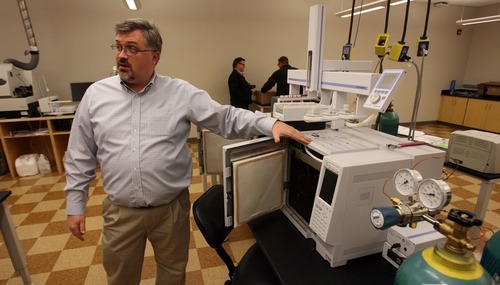This is an archived article that was published on sltrib.com in 2011, and information in the article may be outdated. It is provided only for personal research purposes and may not be reprinted.
Vernal • Utah State University has had boots on the ground here for four decades. But it wasn't until last fall that it put a distinctive new footprint in the community with the opening of the Bingham Entrepreneurship & Energy Research Center.
The $23 million complex aims to be a hub of energy industry innovation, not just for eastern Utah but the world. It also continues to serve as an eastern campus for Utah's only land-grant university and a community resource.
"The Bingham Center is really the focal point for opportunities for the state of Utah and the eastern Utah region to add value-added economic development opportunities," said Robert T. Behunin, USU vice president for commercialization and regional development, at a presentation last year.
By forging strong partnerships between industry, researchers and government, those behind the effort hope to spur more environmentally sustainable development, more jobs and a stronger local economy — an economy that relies on the energy sector for more than half its activity.
The award-winning new building has windows that look out on world-famous scenic attractions like Split Mountain, where the Green River slices through Dinosaur National Monument. Built in the Western Energy Corridor, the center is surrounded by communities with a long history of boom-and-bust cycles and clashes over the environment.
It's also a region where many believe that future prosperity lies in oil shale, oil sands, uranium, coal, gas, rare earth mineral reserves and renewable energy. Oil shale reserves alone, said Behunin, amount to 1.8 trillion barrels, enough to provide 25 percent of the nation's energy needs for 400 years. The center is billed as a bridge between academia and industry, energy development and environmental protection.
Equipped with video setups that allow local students to "attend" classes in Logan and elsewhere, the center maintains a core of laboratories and offices focused on sustainable energy that supports a healthy environment.
Charley C. Langley is one of the Bingham Center's 10 full-time science faculty members. An expert in petroleum chemistry, he is part of the Utah State University Research Foundation's Energy Dynamics Laboratory, which puts the university's facilities and know-how in the service of industry to put research to commercial use.
"The whole idea here is to maximize efficiency," he told Uintah County Commission Chairwoman Darlene Burns and a representative of a Utah oil shale company during a tour recently.
In addition, the Vernal building has become a nerve center for basic research on the Uinta Basin's emerging ozone pollution problem. The work is essential in understanding how to protect public health while allowing the oil and gas industry to continue to grow.
The programs, part of the Eastern Utah Secure Energy Partnership headquartered at the Bingham Center, include unconventional fossil energy development (in collaboration with the U.S. Energy Department) and using algae to clean up drilling-process water. Meanwhile, the complex also hosts a local Small Business Administration Entrepreneurship Center, a state vocational rehabilitation center and meeting rooms.
Uintah County supported the center's construction with about $20 million, much of it from mineral lease funds paid by energy companies for developing natural resources on federal lands. Behunin, besides serving as the USU vice president for commercialization and regional development, is also the executive director of the impact board that provided the funding. —
Bingham Center
70,000 square feet for laboratories, classrooms, meeting rooms and offices
10 scientists and faculty serving about 800 students
$23 million facility, built with $15 million donated by Marc and Debbie Bingham and designed to meet the LEED Silver energy standard
$20 million in roads and improvements furnished in part by the Uintah Impact Mitigation Special Service District
$3.5 million in research programming
$2 million in funding through the Utah Science Technology and Research initiative





